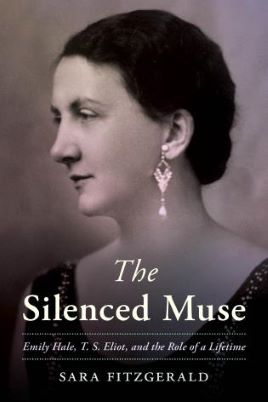How an unearthed archive inspired me to tell a (truer) story about T.S. Eliot.

It’s not often that an author gets to take a second crack at the subject of her book — even if she wants to. But four years after publishing The Poet’s Girl, a novel about T.S. Eliot and his longtime secret love, Emily Hale, I’ve returned to that story. This time, it takes the form of a biography, The Silenced Muse: Emily Hale, T.S. Eliot, and the Role of a Lifetime.
Was I obsessed? Perhaps. But I also discovered that my fictional attempt at capturing the poet and his paramour’s world had gotten some things wrong. I wanted to set the record straight.
I was already a retired journalist, a writer published in fiction and biography, when I first learned about Hale after accessing the Wikipedia entry for the Eliot poem “Burnt Norton.” It explained that Eliot might have wed her if he hadn’t already been married. I knew something of Eliot’s two wives, but nothing about this woman. Soon after, I found out the 1,131 letters Eliot wrote to Hale were scheduled to be opened after a 50-year embargo.
Some milestones in their relationship were already known, but there were still many gaps in the story. Hale left behind personal papers but no diaries and just a few letters. Meanwhile, there were only fleeting references to her in the published volumes of Eliot letters.
What form did their courtship take? What happened on their walk to Burnt Norton? How did Hale react when Eliot decided he couldn’t bring himself to marry her after she’d waited 17 years? How did she feel when he later wed his much younger secretary?
This wouldn’t be a conventional “and they lived happily ever after” love story. But some Eliot biographers claimed Hale fell apart after he remarried. My research suggested otherwise. I believe she was a strong woman who ultimately overcame many tragedies and disappointments, including her relationship with Eliot.
To the extent novelists draw on their own experiences, I plead guilty. I imagined Hale as an extroverted young woman attracted to an intelligent but very shy young man. I’d known plenty of men like that when I was her age and envisioned their courtship this way: Hale was taken with Eliot and sought to draw him out of his shell. When I had to invent a scene, I tried to make it both possible and plausible, based on what we knew of their lives. Fifty years after his death, after all, Eliot has been well defined.
My novel was published just as the trove of embargoed letters was opened at Princeton University Library. I decided I had to be there on that exciting day. As a half-dozen scholars and researchers dove into the correspondence, we discovered it was truly revelatory.
We were delighted to learn that Hale had also sequestered two short memoirs about her relationship with Eliot. As it turned out, I hadn’t portrayed their courtship correctly. Hale recalled that she was surprised and embarrassed when Eliot first declared his love for her. It seemed she’d been too busy pursuing acting opportunities to take much notice of him. But her writings reveal that after Eliot left Boston for a year’s study at Oxford, he wrote and sent flowers. She began to wonder if they might have a future together.
Later on “opening day” came a shocking revelation: In 1960, Eliot sent a letter to Harvard with the instructions that it be opened only when Hale’s letters finally became public. In it, he declared that he’d never really loved her, that his love had been that of “a ghost for a ghost,” and that, had he married her, he never would’ve become a great poet. He went on to detail a list of Hale’s faults, and he confirmed that he’d arranged for her letters to be destroyed.
Coming to light at the height of the #MeToo movement, Eliot’s preemptive letter only drew more media attention to his correspondence with Hale. But some subsequent news stories perpetuated myths about Hale’s life. Eliot’s letters revealed that he was the one who urged Hale to preserve his letters, declaring they would be “a kind of monument” to her. The letters also confirmed that her bequeathing of the archive to Princeton wasn’t a vindictive decision; the donation came before Eliot remarried. In fact, after he died, Hale retrieved and destroyed a more detailed memoir out of sympathy for his widow.
Armed with this new information, I decided to tackle the story again, mining the letters and doing additional research. True, there are still questions I can’t answer, but I’ve at least created a new record — one backed up with footnotes instead of spun out of imagination. I was also able to heed the words Hale herself left behind.
Thanks to the letters, “the biographers of the future will not see through ‘a glass darkly’ — but like all of life ‘face to face,’” she wrote. “After all, I accepted conditions as they were offered under the unnatural code which surrounded us.”
Journalist, editor, and novelist Sara Fitzgerald is the author of The Poet’s Girl: A Novel, The Silenced Muse: Emily Hale, T.S. Eliot, and the Role of a Lifetime, and several other books.

